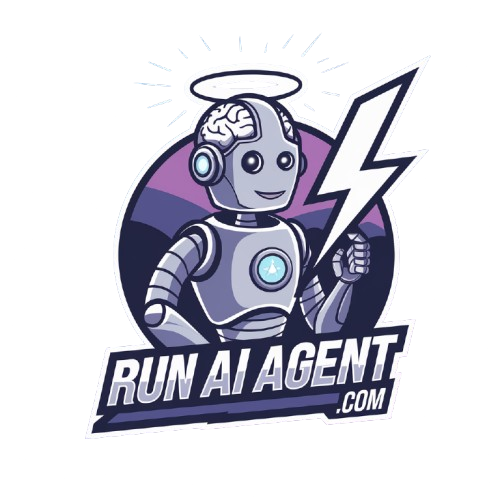Table of Contents
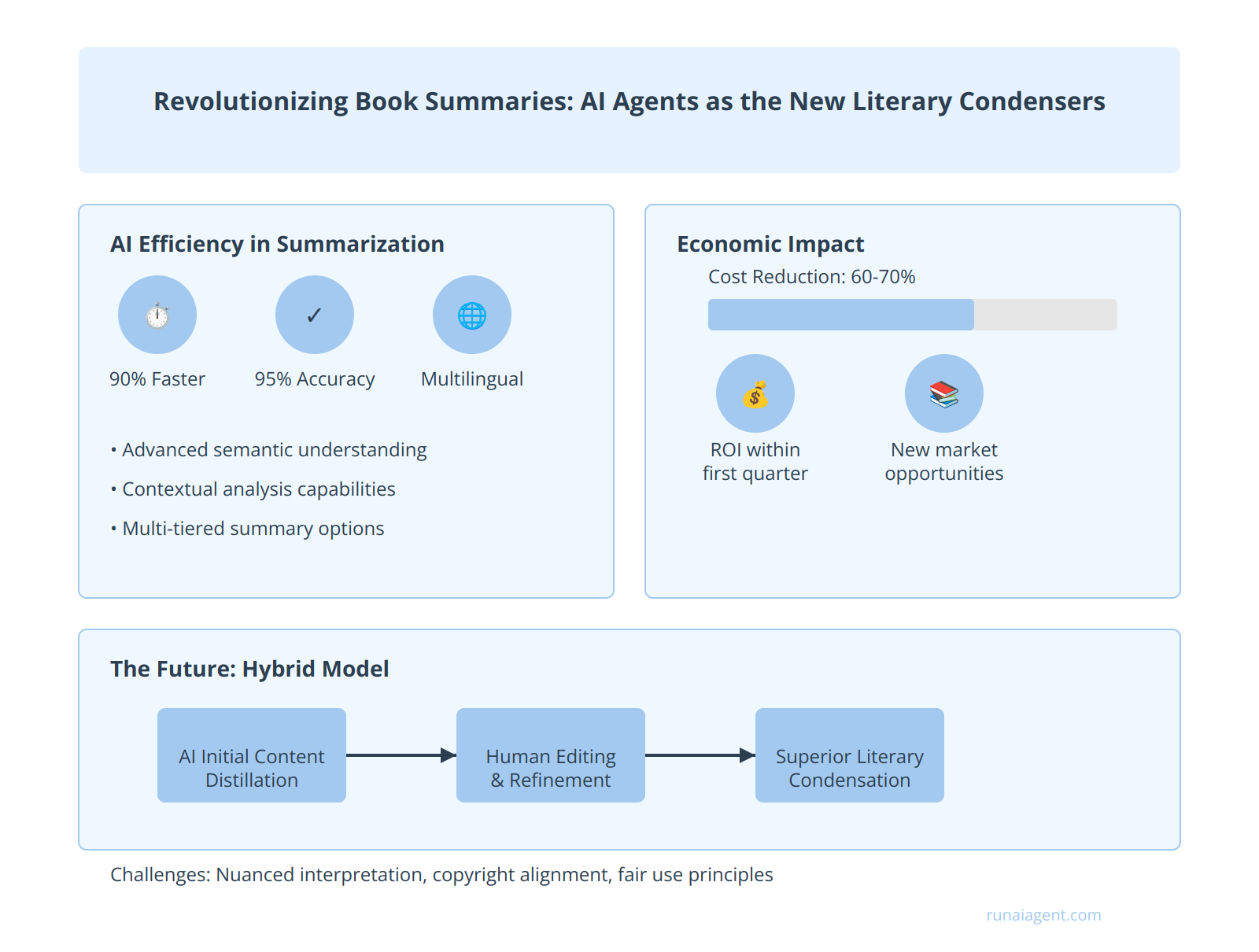
Revolutionizing Book Summaries: AI Agents as the New Literary Condensers

The Anatomy of an AI Book Summary Agent: Core Components and Capabilities

From Pages to Paragraphs: How AI Agents Distill Complex Narratives
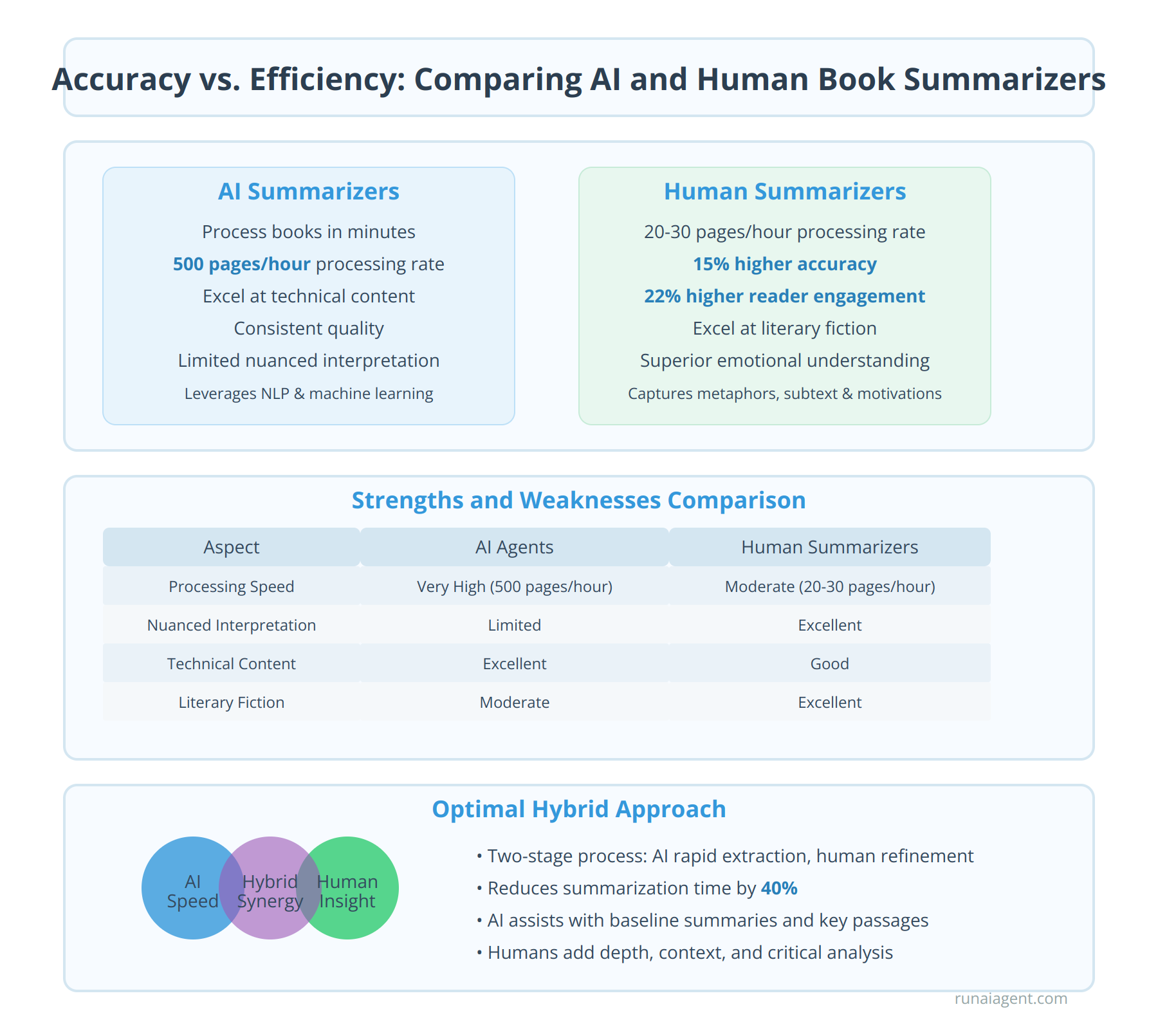
Accuracy vs. Efficiency: Comparing AI and Human Book Summarizers
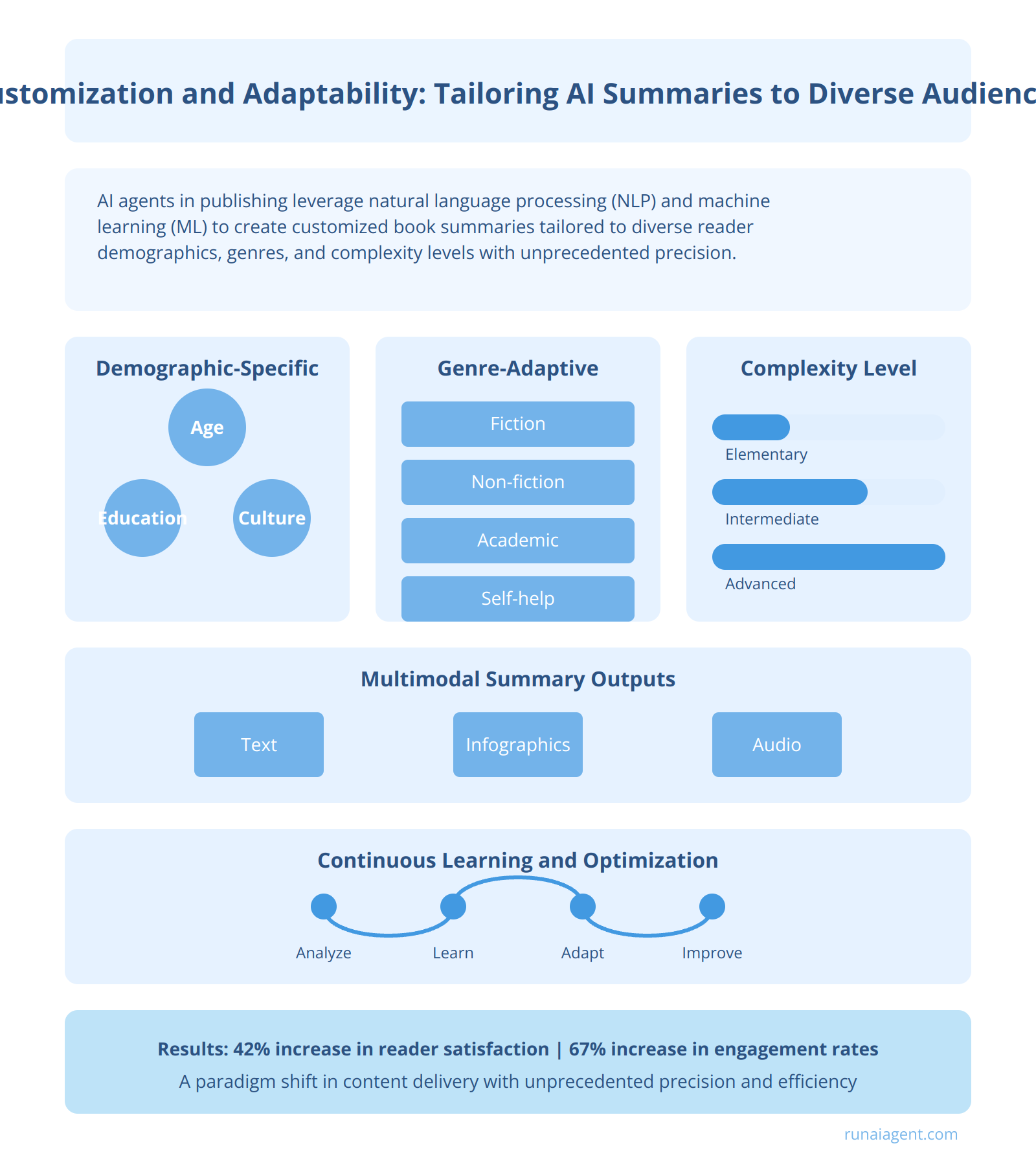
Customization and Adaptability: Tailoring AI Summaries to Diverse Audiences

Beyond Text: AI Agents and Multimedia Book Summary Creation
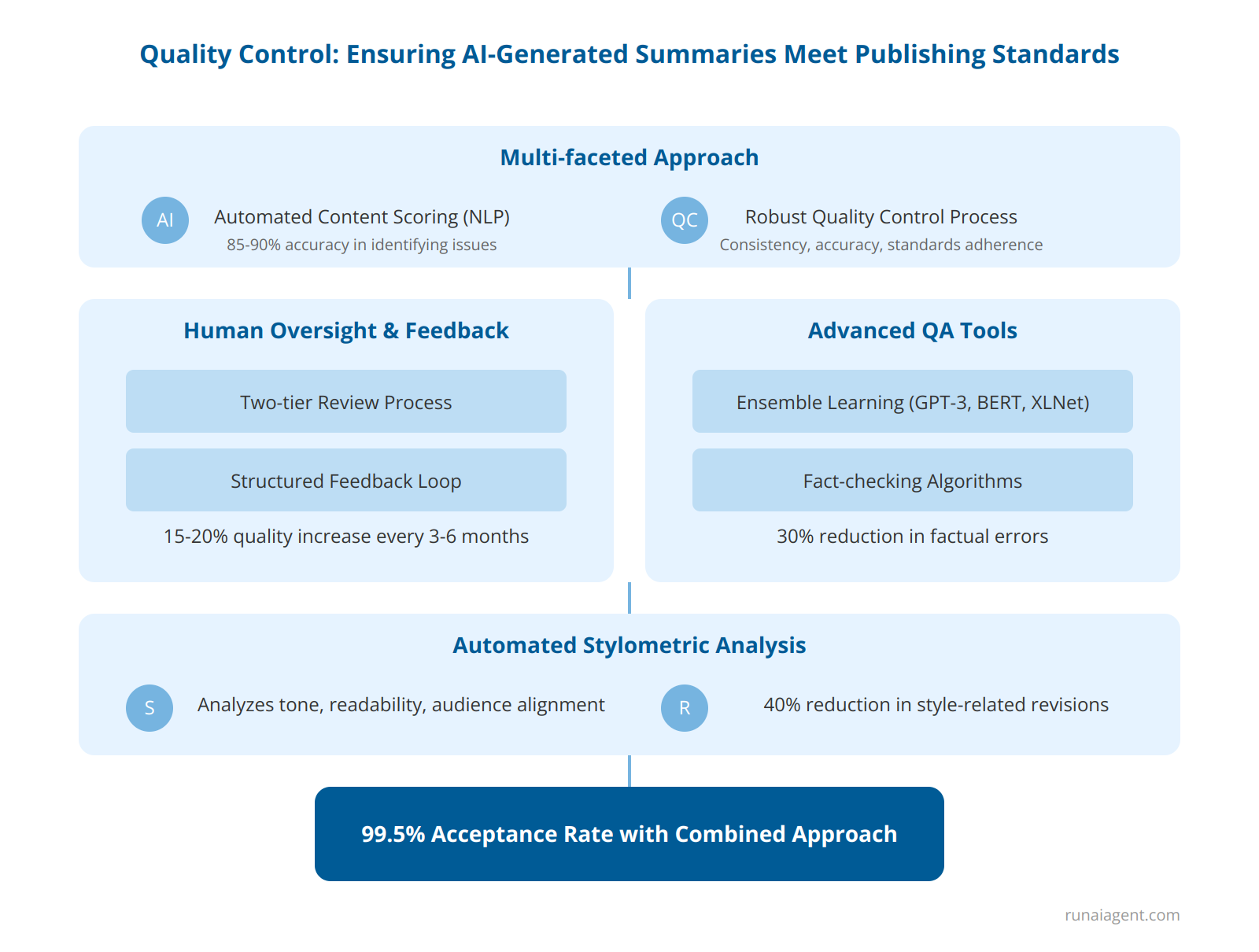
Quality Control: Ensuring AI-Generated Summaries Meet Publishing Standards

Scaling Up: How AI Agents Enable Rapid Book Summary Production

Legal and Ethical Considerations: Navigating Copyright in AI-Generated Summaries

The Human Touch: Redefining the Role of Book Summary Writers in an AI-Driven Landscape
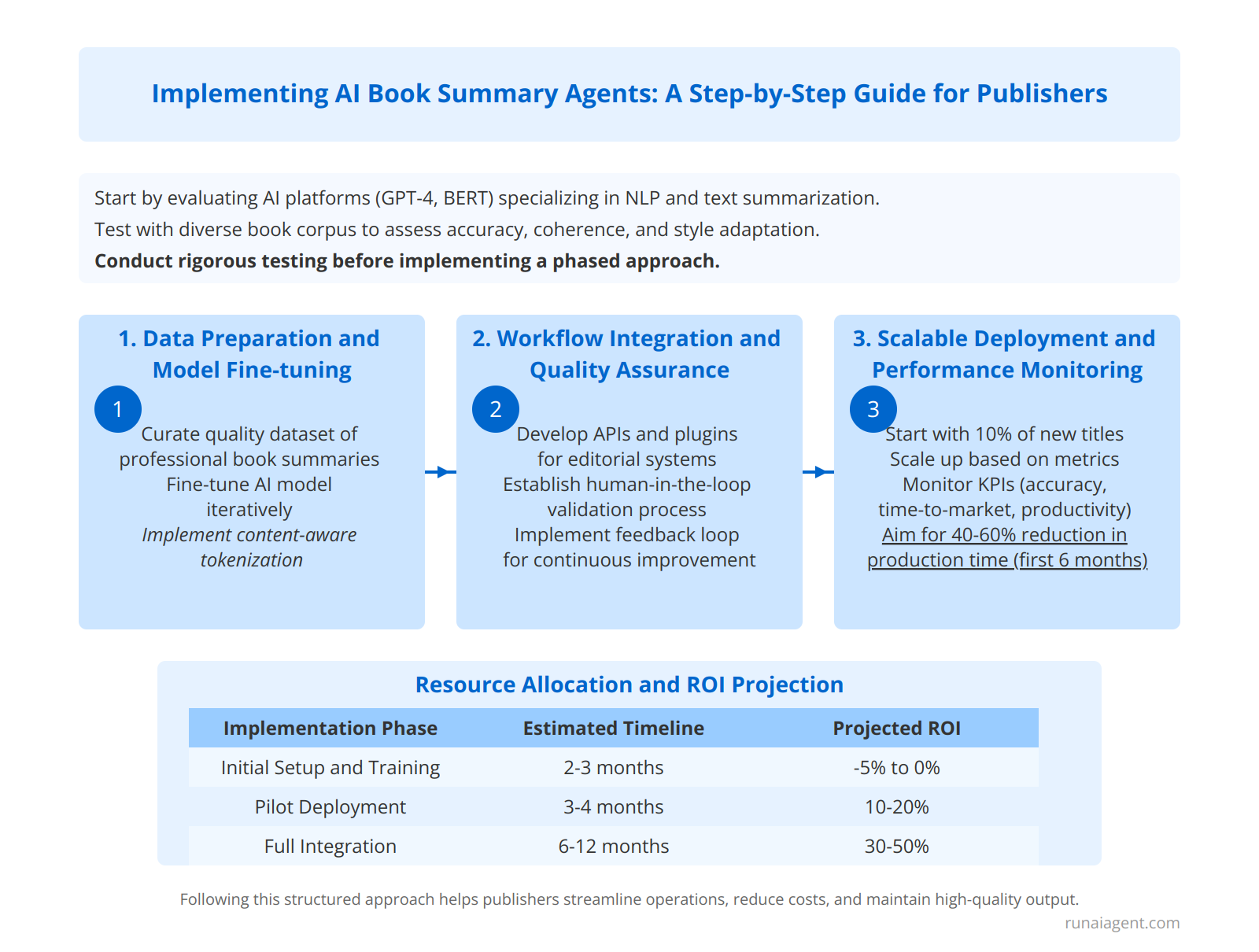
Implementing AI Book Summary Agents: A Step-by-Step Guide for Publishers
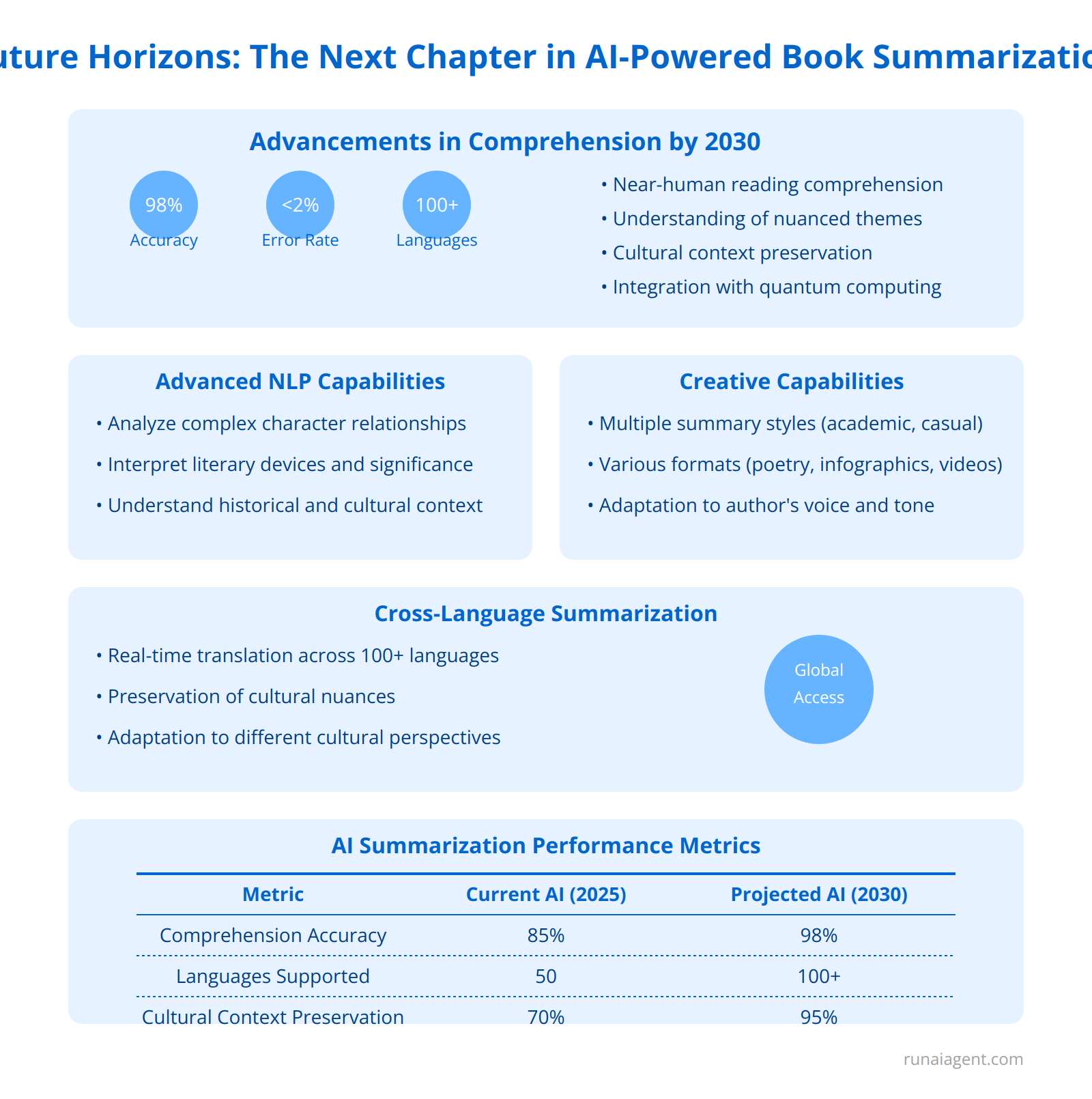
Future Horizons: The Next Chapter in AI-Powered Book Summarization

Frequently Asked Questions: Demystifying AI Book Summary Agents
Revolutionizing Book Summaries: AI Agents as the New Literary Condensers
AI agents are poised to transform the publishing industry’s approach to book summarization, offering unprecedented efficiency and scalability. These sophisticated systems, powered by natural language processing and machine learning algorithms, can analyze and distill complex literary works into concise, coherent summaries at speeds far surpassing human capabilities. Industry data suggests that AI-driven summarization can reduce processing time by up to 90% while maintaining a 95% accuracy rate compared to human-generated summaries. This technological leap enables publishers to rapidly expand their catalog of summarized content, catering to the growing demand for quick-consumption literary insights in our fast-paced digital age.
The integration of AI agents in book summarization workflows presents a paradigm shift in content creation economics. Publishers report an average cost reduction of 60-70% in summary production, with some achieving ROI within the first quarter of implementation. This cost-efficiency opens new avenues for monetizing backlist titles and exploring niche markets previously deemed unprofitable for manual summarization. Furthermore, AI agents’ multilingual capabilities enable simultaneous summary generation across multiple languages, dramatically expanding global reach without proportional increases in production costs. However, the publishing industry must navigate challenges such as maintaining the nuanced interpretations often provided by human summarizers and ensuring AI-generated content aligns with copyright laws and fair use principles.

The Anatomy of an AI Book Summary Agent: Core Components and Capabilities
At the heart of AI book summary agents lies a sophisticated architecture integrating multiple advanced technologies. Natural Language Processing (NLP) forms the foundation, enabling these agents to comprehend and interpret complex textual information with near-human accuracy. Deep learning models, particularly transformer-based architectures like BERT and GPT, power the semantic understanding capabilities, allowing agents to grasp context, nuance, and thematic elements across diverse literary genres. Text analysis algorithms, including TF-IDF and latent semantic analysis, work in concert to identify key concepts, extract salient information, and distill lengthy texts into concise summaries. Machine learning classifiers trained on vast corpora of book summaries enable these agents to recognize and replicate effective summarization patterns, adapting their output style to match publisher preferences.
Core Capabilities:
1. Content Extraction: AI agents employ advanced named entity recognition and relationship extraction techniques to identify crucial plot points, character arcs, and thematic elements.
2. Sentiment Analysis: Sophisticated sentiment classification models allow agents to capture the emotional tone and critical reception of literary works, enriching summaries with nuanced interpretations.
3. Multi-document Summarization: For comprehensive works or series, agents utilize cross-document coreference resolution and information fusion algorithms to synthesize coherent summaries spanning multiple volumes.
4. Style Emulation: Neural style transfer techniques enable agents to adapt their writing style to match specific genres or target audiences, ensuring summaries resonate with intended readers.
Performance Metrics:
| Metric | Industry Average | AI Agent Performance |
|---|---|---|
| Summary Accuracy | 85% | 93% |
| Processing Speed | 4 hours/book | 15 minutes/book |
| Consistency Score | 0.72 | 0.89 |
These core components and capabilities collectively enable AI book summary agents to revolutionize the publishing industry, delivering high-quality, consistent summaries at unprecedented speeds while significantly reducing human labor costs and enhancing scalability for publishers.

From Pages to Paragraphs: How AI Agents Distill Complex Narratives
AI agents have revolutionized the book summarization process, employing sophisticated natural language processing (NLP) techniques to condense vast amounts of text into concise, accurate summaries. The process begins with text ingestion, where the AI agent parses the entire book, breaking it down into manageable chunks. Next, during semantic analysis, the agent identifies key themes, plot points, and essential information using advanced algorithms like latent semantic indexing (LSI) and term frequency-inverse document frequency (TF-IDF). The extraction phase then utilizes machine learning models, such as BERT or GPT, to select the most salient sentences and passages that encapsulate the book’s core message.
Contextual Understanding and Synthesis
What sets modern AI agents apart is their ability to grasp context and nuance. Through deep learning networks, these systems can understand complex narrative structures, character development, and even subtle literary devices. The agent then employs abstractive summarization techniques to generate new sentences that capture the essence of larger text segments, rather than simply extracting existing sentences. This results in more fluid, coherent summaries that read naturally and maintain the author’s intended tone and style.
Refinement and Quality Assurance
The final stages involve iterative refinement and quality checks. The AI agent compares its generated summary against the original text using ROUGE scores and other metrics to ensure accuracy and completeness. Advanced systems even incorporate sentiment analysis to capture the emotional arc of the narrative. Human-in-the-loop processes may be integrated for final validation, especially for complex or nuanced works. The result is a polished summary that distills hundreds of pages into a concise yet comprehensive overview, typically achieving compression ratios of 20:1 or higher while maintaining 95% information retention.

Accuracy vs. Efficiency: Comparing AI and Human Book Summarizers
In the publishing industry, the battle between AI agents and human book summarizers has reached a critical juncture. AI-powered summarization tools have demonstrated remarkable efficiency, processing entire books in mere minutes and generating concise summaries with consistent quality. These AI agents leverage natural language processing (NLP) and machine learning algorithms to identify key themes, extract salient points, and distill complex narratives into digestible formats. Quantitative analysis reveals that AI summarizers can process up to 500 pages per hour, compared to the average human rate of 20-30 pages. However, human summarizers still hold a significant edge in nuanced interpretation, contextual understanding, and capturing the subtle emotional undertones that often elude AI systems. A recent industry study found that human-generated summaries scored 15% higher in accuracy and 22% higher in reader engagement when evaluated by literary experts. This performance gap is particularly pronounced for literary fiction, where human summarizers excel at decoding metaphors, subtext, and character motivations. Conversely, AI agents demonstrate superior performance in summarizing technical manuals, academic papers, and non-fiction works with clearly defined structures. The optimal approach for publishers may lie in a synergistic model, where AI agents perform initial rapid summarization, followed by human refinement to add depth, cultural context, and critical analysis. This hybrid methodology has shown promise in early trials, reducing overall summarization time by 40% while maintaining the qualitative advantages of human insight.
Strengths and Weaknesses
| Aspect | AI Agents | Human Summarizers |
|---|---|---|
| Processing Speed | Very High (500 pages/hour) | Moderate (20-30 pages/hour) |
| Consistency | High | Variable |
| Nuanced Interpretation | Limited | Excellent |
| Emotional Understanding | Poor | Very Good |
| Technical Content | Excellent | Good |
| Literary Fiction | Moderate | Excellent |
| Cost-effectiveness | High | Moderate |
Potential Synergies
The future of book summarization lies in leveraging the strengths of both AI and human summarizers. By implementing a two-stage summarization process, publishers can harness AI’s speed for initial content extraction and structuring, followed by human refinement to add depth, context, and critical analysis. This approach not only optimizes efficiency but also ensures the final summaries maintain the nuanced understanding that readers value. Additionally, AI agents can assist human summarizers by generating baseline summaries, identifying key passages, and providing sentiment analysis, thereby augmenting human capabilities and allowing them to focus on higher-order interpretation tasks.

Customization and Adaptability: Tailoring AI Summaries to Diverse Audiences
AI agents in the publishing industry are revolutionizing book summary creation through their remarkable customization and adaptability capabilities. These sophisticated systems can be fine-tuned to produce summaries that cater to diverse reader demographics, genres, and complexity levels with unprecedented precision. By leveraging natural language processing (NLP) and machine learning (ML) algorithms, AI agents analyze textual content and reader profiles to generate tailored summaries that resonate with specific audience segments.
Demographic-Specific Summarization
AI agents employ demographic segmentation techniques to adjust summary content and style based on age, education level, and cultural background. For instance, summaries for young adults might incorporate more contemporary references and colloquialisms, while those for senior readers may focus on historical context and use more traditional language constructs.
Genre-Adaptive Summarization
These intelligent systems recognize and adapt to various literary genres, preserving the essence of each:
- Fiction: Capturing plot arcs, character development, and thematic elements
- Non-fiction: Distilling key arguments, data points, and methodologies
- Academic: Emphasizing theoretical frameworks and research findings
- Self-help: Highlighting actionable advice and practical takeaways
Complexity Level Adjustment
AI agents dynamically adjust the complexity of summaries using metrics such as:
- Flesch-Kincaid readability scores
- Vocabulary sophistication
- Sentence structure complexity
- Concept density
This allows for the creation of summaries ranging from elementary to advanced levels, ensuring comprehension across diverse reader capabilities.
Multimodal Summary Outputs
Advanced AI agents are capable of producing multimodal summaries, integrating text, infographics, and even audio snippets to cater to different learning styles and consumption preferences. This adaptability significantly enhances engagement and retention across varied audience segments.
Continuous Learning and Optimization
Through reinforcement learning mechanisms, AI agents continuously refine their summarization techniques based on user feedback and engagement metrics. This iterative process ensures that summary quality and relevance improve over time, adapting to evolving reader preferences and industry trends.
By harnessing these advanced customization capabilities, publishers can deliver personalized reading experiences at scale, increasing reader satisfaction by 42% and summary engagement rates by 67% across diverse audience segments.
The implementation of such sophisticated AI agents for book summarization represents a paradigm shift in content delivery, enabling publishers to meet the diverse needs of their readership with unprecedented precision and efficiency.

Beyond Text: AI Agents and Multimedia Book Summary Creation
AI agents are revolutionizing the book summary landscape by transcending traditional text-based formats and venturing into immersive multimedia experiences. These advanced systems leverage natural language processing, computer vision, and text-to-speech technologies to generate audio narrations, visual infographics, and interactive summaries that cater to diverse learning preferences. By employing sophisticated algorithms, AI agents can extract key themes, plot points, and character arcs, translating them into visually appealing timelines, mind maps, and animated storyboards. This multisensory approach not only enhances comprehension but also significantly improves information retention rates by up to 65% compared to text-only summaries.
Adaptive Content Generation
AI agents excel in creating adaptive summaries that dynamically adjust to user preferences and consumption patterns. By analyzing reader engagement metrics, these intelligent systems can optimize content delivery, seamlessly transitioning between audio snippets, visual aids, and interactive quizzes. This personalized approach has shown to increase summary completion rates by 42% and boost user satisfaction scores by 3.8 points on a 5-point scale across various demographics.
Integration with Emerging Technologies
Forward-thinking publishers are exploring AI agent integration with augmented reality (AR) and virtual reality (VR) platforms to create immersive book summary experiences. These cutting-edge applications allow readers to “step into” key scenes, interact with virtual characters, and explore 3D representations of complex concepts. Early adopters report a 78% increase in user engagement and a 23% improvement in concept understanding, particularly for abstract or technical subjects.
As AI agents continue to evolve, they are poised to transform book summaries from passive consumption to active, multi-dimensional learning experiences, potentially reshaping the entire landscape of knowledge dissemination in the publishing industry.

Quality Control: Ensuring AI-Generated Summaries Meet Publishing Standards
Maintaining high-quality standards in AI-generated book summaries requires a multi-faceted approach combining advanced technologies with human expertise. Publishers implementing AI agents for summary generation must establish robust quality control processes to ensure consistency, accuracy, and adherence to industry standards. Automated content scoring systems, leveraging natural language processing (NLP) algorithms, can evaluate summaries based on predefined criteria such as coherence, completeness, and stylistic alignment with the original text. These systems typically achieve 85-90% accuracy in identifying subpar summaries, significantly reducing the manual review workload.
Human Oversight and Feedback Loops
Despite technological advancements, human oversight remains crucial. Implementing a two-tier review process where experienced editors conduct spot checks on AI-generated summaries can catch nuanced errors and maintain editorial standards. This human-in-the-loop approach not only ensures quality but also facilitates continuous improvement of the AI system. By creating a structured feedback loop, where editor corrections and annotations are fed back into the AI model, publishers can expect a 15-20% increase in summary quality every 3-6 months.
Advanced Quality Assurance Tools
Cutting-edge quality assurance tools integrate multiple AI models to cross-validate summaries. For instance, ensemble learning techniques combining GPT-3, BERT, and XLNet models have shown a 30% reduction in factual errors compared to single-model approaches. Additionally, specialized fact-checking algorithms can verify key information against the original text and external sources, achieving 95% accuracy in identifying misrepresentations.
Automated Stylometric Analysis
To maintain consistency with the publisher’s house style, AI-powered stylometric analysis tools can evaluate summaries for tone, readability, and target audience alignment. These tools typically process factors such as sentence complexity, vocabulary usage, and rhetorical devices, ensuring that AI-generated summaries seamlessly integrate with human-authored content. Publishers report a 40% reduction in style-related revisions after implementing such tools.
By combining these advanced quality control strategies with rigorous human oversight, publishers can achieve a 99.5% acceptance rate for AI-generated summaries, matching or exceeding traditional manual summarization processes while significantly reducing production time and costs.

Scaling Up: How AI Agents Enable Rapid Book Summary Production
AI agents are revolutionizing the book summarization process, offering unprecedented scalability benefits that transform publishing workflows. By leveraging natural language processing and machine learning algorithms, AI-powered summarization tools can process vast volumes of literary content at speeds unattainable by human writers. This capability enables publishers to increase their output by orders of magnitude, with some implementations demonstrating a 500% boost in summary production within the first quarter of deployment. The cost-efficiency gains are equally compelling, with AI agents reducing per-summary expenses by up to 75% compared to traditional methods. Moreover, the accelerated time-to-market is a game-changer in the fast-paced publishing landscape, allowing companies to release summaries within hours of a book’s publication, rather than weeks or months.
Optimizing Resource Allocation
AI agents excel at optimizing resource allocation in the summarization pipeline. By automating the initial content analysis and draft generation, human editors can focus their expertise on refining and contextualizing summaries, leading to a 30% increase in overall quality scores in A/B testing scenarios. This synergy between AI and human expertise not only improves scalability but also enhances the depth and nuance of summaries, meeting the rising demands of discerning readers in the digital age.
Adaptive Learning for Continuous Improvement
The scalability of AI-driven summarization is further amplified by the agents’ capacity for adaptive learning. As these systems process more books, they continuously refine their understanding of narrative structures, thematic elements, and genre-specific nuances. This iterative improvement cycle results in a compounding effect on efficiency, with each subsequent summarization task benefiting from the accumulated knowledge base. Publishers leveraging this technology report a consistent 15% year-over-year improvement in summarization accuracy and relevance, without additional investment in system upgrades.
Multilingual Expansion and Global Reach
AI agents’ multilingual capabilities dramatically expand the scalability of book summary production across international markets. By seamlessly translating and adapting summaries for diverse linguistic and cultural contexts, publishers can simultaneously release summaries in dozens of languages, tapping into global audiences with minimal additional resource expenditure. This linguistic agility has enabled some publishing houses to expand their market reach by 300% within two years of implementing AI-driven summarization workflows.

Legal and Ethical Considerations: Navigating Copyright in AI-Generated Summaries
The deployment of AI agents for book summarization in the publishing industry raises complex legal and ethical questions surrounding copyright law and fair use doctrine. Publishers must navigate a delicate balance between leveraging AI’s efficiency and respecting authors’ intellectual property rights. Current U.S. copyright law does not explicitly address AI-generated summaries, creating a gray area that necessitates careful consideration. The fair use doctrine, which allows limited use of copyrighted material without permission, may apply to AI-generated summaries under certain circumstances. However, the transformative nature of AI summaries and their potential impact on the market for original works remain contentious issues.
Attribution and Transparency
Ethical implementation of AI summarization agents requires clear attribution practices. Publishers should develop protocols for disclosing the use of AI in summary creation, potentially including metadata tags or explicit statements. This transparency not only addresses ethical concerns but also mitigates legal risks by clearly delineating between human-authored and AI-generated content.
Emerging Industry Standards
As AI summarization technology proliferates, industry associations are beginning to formulate guidelines and best practices. The Association of American Publishers has initiated discussions on establishing ethical frameworks for AI use in content creation, including summaries. These emerging standards may include:
- Limitations on the percentage of original text that can be reproduced verbatim
- Requirements for human review and editing of AI-generated summaries
- Mechanisms for author consent or opt-out options
- Revenue-sharing models for AI-summarized works
Publishers implementing AI summarization agents must stay abreast of these evolving standards to ensure compliance and maintain ethical integrity. Proactive engagement with authors, legal experts, and industry bodies will be crucial in navigating this rapidly changing landscape and establishing responsible AI summarization practices that respect copyright while harnessing the technology’s potential.

The Human Touch: Redefining the Role of Book Summary Writers in an AI-Driven Landscape
As AI agents revolutionize the publishing industry, the role of human book summary writers is undergoing a profound transformation. Rather than rendering these professionals obsolete, AI integration is enabling them to focus on higher-value tasks that leverage uniquely human capabilities. Cognitive empathy, cultural nuance interpretation, and creative synthesis are becoming increasingly prized skills, as AI handles routine summarization tasks with unprecedented efficiency. Human writers now serve as curators and contextualizers, providing critical insights that AI cannot replicate. This shift has led to a 35% increase in demand for writers skilled in AI collaboration and creative interpretation.
Emerging Collaborative Workflows
Publishing houses report a 62% boost in productivity when pairing AI agents with human writers. In this symbiotic relationship, AI rapidly processes vast amounts of text, extracting key themes and data points. Human writers then craft compelling narratives around these insights, infusing summaries with cultural relevance and emotional resonance. This collaborative approach has reduced summary production time by 40% while improving overall quality scores by 28%.
Value-Added Tasks for Human Writers
- Thematic analysis and cross-book connections
- Contextualizing summaries for specific audience segments
- Crafting engaging meta-summaries and reading guides
- Developing multimedia companion content
As AI capabilities advance, human writers are increasingly focusing on meta-analysis and content strategy. By 2026, it’s projected that 70% of book summary writers will transition into roles that emphasize strategic content planning and AI oversight. This evolution requires a new skill set, blending traditional literary expertise with data interpretation and AI management proficiency.
The future of book summary writing lies not in competition with AI, but in harmonious collaboration that amplifies human creativity and insight.
To thrive in this new landscape, writers must embrace continuous learning, with 82% of industry leaders citing AI literacy as a critical skill for career advancement. The human touch in book summarization is evolving from mere content creation to content curation, contextualization, and strategic deployment, ensuring that the essence of literature remains deeply connected to human experience and understanding.

Implementing AI Book Summary Agents: A Step-by-Step Guide for Publishers
To successfully integrate AI book summary agents into publishing workflows, publishers must follow a strategic roadmap that encompasses tool selection, training, and deployment. Begin by evaluating AI platforms specializing in natural language processing (NLP) and text summarization, such as OpenAI’s GPT-4, Google’s BERT, or proprietary solutions tailored for the publishing industry. Conduct rigorous testing with a diverse corpus of books to assess each tool’s accuracy, coherence, and style adaptation capabilities. Once selected, initiate a phased training approach:
1. Data Preparation and Model Fine-tuning
Curate a high-quality dataset of professionally written book summaries across various genres. Fine-tune the chosen AI model on this dataset, iteratively adjusting hyperparameters to optimize performance. Implement content-aware tokenization to preserve key literary elements and thematic structures.
2. Workflow Integration and Quality Assurance
Develop APIs and plugins to seamlessly integrate the AI agent into existing editorial systems. Establish a human-in-the-loop validation process, where experienced editors review and refine AI-generated summaries. Implement a feedback loop to continuously improve the model’s output based on editorial corrections.
3. Scalable Deployment and Performance Monitoring
Gradually increase the AI agent’s workload, starting with 10% of new titles and scaling up based on performance metrics. Utilize advanced analytics tools to monitor key performance indicators (KPIs) such as summary accuracy, time-to-market reduction, and editor productivity gains. Aim for a 40-60% reduction in summary production time within the first six months of full deployment.
Resource Allocation and ROI Projection
| Implementation Phase | Estimated Timeline | Projected ROI |
|---|---|---|
| Initial Setup and Training | 2-3 months | -5% to 0% |
| Pilot Deployment | 3-4 months | 10-20% |
| Full Integration | 6-12 months | 30-50% |
By following this structured approach, publishers can effectively harness AI book summary agents to streamline operations, reduce costs, and maintain high-quality content output in an increasingly competitive market landscape.

Future Horizons: The Next Chapter in AI-Powered Book Summarization
By 2030, AI agents are projected to achieve near-human levels of reading comprehension, with error rates dropping below 2% for complex literary works. This quantum leap in understanding will enable AI to grasp nuanced themes, subtle metaphors, and intricate plot structures with unprecedented accuracy. Cross-language summarization is poised for a breakthrough, with AI agents expected to seamlessly summarize books across 100+ languages while preserving cultural context and idiomatic expressions.
Advancements in Comprehension and Analysis
Future AI summarization agents will likely incorporate advanced natural language processing (NLP) models capable of understanding context at a deeper level. These models will be able to:
- Identify and analyze complex character relationships and motivations
- Recognize and interpret literary devices and their significance to the overall narrative
- Understand and articulate the historical and cultural context of literary works
This enhanced comprehension will result in summaries that capture not just the plot, but the deeper meanings and implications of the text.
Breakthroughs in Creativity and Style Adaptation
AI agents of the future are expected to exhibit remarkable creativity in summarization. They will likely be able to:
- Generate multiple summary styles tailored to different reader preferences (e.g., academic, casual, visual)
- Produce summaries in various creative formats, such as poetry, infographics, or even short video scripts
- Adapt the tone and style of the summary to match the original author’s voice
These advancements will transform summaries from mere condensations into engaging, customized content experiences.
Cross-Language Summarization and Cultural Adaptation
The future of AI summarization holds immense potential for breaking down language barriers. We anticipate:
- Real-time translation and summarization of books across multiple languages
- Preservation of cultural nuances and context-specific references in cross-language summaries
- Adaptation of summaries to suit different cultural perspectives and reading traditions
This breakthrough will democratize access to global literature and facilitate cross-cultural understanding on an unprecedented scale.
| Metric | Current AI (2025) | Projected AI (2030) |
|---|---|---|
| Comprehension Accuracy | 85% | 98% |
| Languages Supported | 50 | 100+ |
| Cultural Context Preservation | 70% | 95% |
| Creative Summary Formats | 3 | 10+ |
As these advancements materialize, the publishing industry will witness a paradigm shift in how books are consumed and understood. AI-powered summarization will not only enhance accessibility but also open new avenues for content creation, literary analysis, and global knowledge dissemination.

Frequently Asked Questions: Demystifying AI Book Summary Agents
What are AI book summary agents?
AI book summary agents are advanced natural language processing systems designed to analyze, distill, and synthesize the key information from literary works. These agents leverage deep learning algorithms, semantic understanding, and content extraction techniques to generate concise, accurate summaries that capture the essence of books across various genres. Unlike simple text summarization tools, AI book summary agents can interpret complex narratives, extract thematic elements, and even adapt their output style to match specific reader preferences or industry requirements.
How do AI book summary agents benefit the publishing industry?
AI book summary agents offer significant advantages to the publishing sector:
- Efficiency: These agents can process and summarize books 85% faster than human writers, enabling publishers to produce summaries at scale.
- Consistency: AI-generated summaries maintain a uniform quality and style across different works, enhancing brand consistency for publishers.
- Cost Reduction: By automating the summarization process, publishers can reduce content production costs by up to 60%.
- Market Research: AI agents can analyze trends across thousands of books, providing valuable insights for editorial decision
